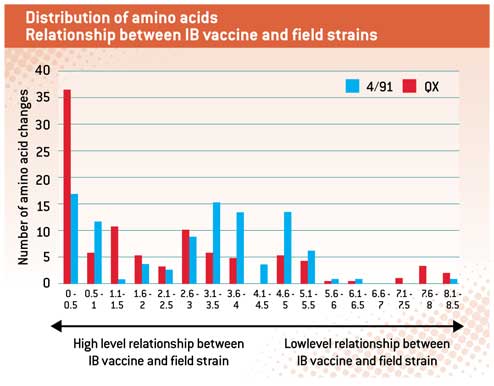Technology takes the strain in the fight against IB

Accurate and extensive diagnosis is critical to keep on top of infectious bronchitis in broilers and layers
An ever-expanding pool of PCR (Polymerase Chain Reaction) test results is providing a comprehensive picture across Europe of the existing and emerging strains of infectious bronchitis (IB) in poultry flocks.
Furthermore, the adoption of novel diagnostic techniques is now enabling poultry vets to establish with greater confidence the most appropriate vaccine programmes to introduce to infected or at-risk flocks.
These advances are partly due to the large number of samples being evaluated. But just as important has been the continual evaluation and molecular profiling of the strains.
Recently-available data provides a clear picture of the instances of known IB variants, as well as clarification of which vaccine types provide the best protection.
Richard Currie (pictured) from X-OvO Diagnostic Solutions has been working closely with MSD Animal Health for the past five years, supporting vets and producers with strain identification and an accurate interpretation of test results to describe the IB profile of their flocks.
In the UK in excess of 1,500 flock samples have now been analysed and results provided.
“PCR testing, coupled with RNA sequencing, is now delivering a much more accurate level of virus strain identification than when we were working purely with ELISA and HI testing,” says Dr Currie. “We have recently presented testing results for the 12-month period to November 2012 and the overall picture confirms five key strains identified. Of these, the 4/91 segment is the most prevalent.”
Vaccination programmes
While vaccination options exist for all the key strains, understanding how the structure of the vaccine virus, that stimulate the host’s immune response, relates to the equivalent part of the field virus is key to choosing the best programme.
Research by X-OvO points to different ways in which proteins in these parts of the IB virus can change shape, following the introduction of different amino acids.
Comparisons of these predicted shapes between field viruses and vaccine strains give a way to assess if a particular vaccine is likely to work well against the field virus that is present, says Dr Currie.
“Essentially we understand that the individual amino acids that make up the important virus proteins have a predisposition to point away from water (hydrophobic) or point towards water (hydrophilic).
“We can use this information to measure how much the protein shape is likely to change in the field virus relative to the vaccine vial virus. If the shape doesn’t change very much, a simple vaccination strategy with one particular live monovalent vaccine is likely to be successful.”
The current challenge to developing viable vaccine programmes for some of the emerging IB strains, such as QX, is that the field viruses have a high level of variability. The strains are, from a genetic and amino acid sequence perspective, distantly related to the current vaccine strain (see bar chart).

Conversely, in the case of 4/91, the molecular profile of the field strains are more closely related to the vaccine strain, which therefore suggests a much greater probability of protection from the existing available vaccine.
Technical manager with MSD Animal Health, Tibor Cserep, believes that it is the ongoing process of testing and reporting that will provide the best possible opportunity for vets and producers to develop viable vaccine programmes.
“The key is to build on the experience and data from the results we have and to continue our IB diagnostic support. These tools are designed to support, not replace veterinary observation and good health management. Our priority is to introduce the service when the vet determines it is best suited and work with them to ensure that any resulting diagnosis is as informed as possible.
“The fact that our partner in this field, X-OvO, is continuing to identify the prevailing and new IB strains, and research the nature, movement and behaviour of the strains, is providing the industry in the UK with a powerful tool to plan and implement vaccine programmes,” says Dr Cserep.
Producers interested in receiving information on IB strain identification and diagnostics should contact their vet or telephone MSD Animal Health on 0370 060 3380.
